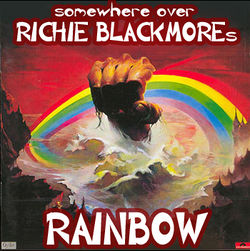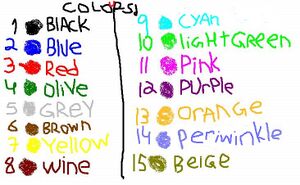Colour
“Roses are red, violets are blue, but both types of flowers are divided into categories, often by colour. So, in fact, red violets and blue roses are both possible, and both occur frequently. But that’s irrelevant, because even the most common varieties of violets are purple, which isn’t blue. Depending on seasonal variants, temperature, humidity, seas rising and global warming the colour may become slightly lighter then blue like a light blue; or even grey if the flowers are dying, marry me?”
– a hopeless romantic
Color (American English) or colour (Prissy English) is a sensation derived from the ability of the eye to distinguish various visible electroumagnetic wavelengths.
Colour is something British people see when they look around. They spell it "colour" because they can't spell words correctly. Canadians do this, however, because they are so Perfeuct, have 20.45 crimes a year, and make maple syrup in their trousers.
History[edit | edit source]

During an experiment with a glass prism in 1665 Sir Isaac Newton noticed that plain white light was split into seven "colours" when shone on a piece of whitefish. The world was exclusively in black and white before this time.
During the 19th century colours became available to the upper classes. Blues were given to people good at sport attending Oxford and Cambridge Universities from 1860, Bishops took purple from 1876, and toffs riding horses obtained the incorrectly named "Pinks" (they were in fact red) shortly afterwards.
Colours were given their current names in 1882, during the second coming of Leonardo Da Vinci. The first ever colour invented was Beige: in richer countries they managed Sepia.
The widespread use of colour after the Second World War slowly made the general population realise there was actually no such thing as black or white people, this being a consequence of monochromism in the 19th century. Sadly this took more time in the poor south of America.
Colors nowadays like orange costs $15/month. The days of free colors are gone.
True colours[edit | edit source]
The practice of "showing true colours" was invented in 1337 by the British Royal Navy and successfully employed in the 1759 invasion and conquest of Québec.
Upon arrival in a hostile area, a British warship would be entirely black-and-white; these big old grey warships would therefore be invisible in the monochrome environment seen in black-and-white photos of the era. The monochrome flags would be indistinguishable from those of any other nation; for instance, the French flag is blank white.
Once past the enemy's defences, the ship and its crew would land at a suitable disembarcation point, then change from monochrome to colour. The Union Jack would suddenly appear in all of its red, white and blue glory; the surrounding waters would turn sparkling blue; the grass on the other side of the fence would become green and the British forces would be free to majestically invoke the ruby-red laser of impending doom upon their hapless enemy.
When confronted with this tactic, the French general Montcalm attempted to cry Wolfe to warn les Canadiens of the arrival of the famed British general, but it was by then far too late and la Nouvelle France was pwned.
Warfare[edit | edit source]
World War II was fought largely in black-and-white, making it difficult to identify friendly forces and enemy combatants as the flags and uniforms all look the same in monochrome. This prolonged the war effort by many years.
In the Cold War era following WWII, efforts to introduce colour to the USA met with stiff opposition from McCarthyist forces who perceived it as a further infiltration of the red menace. When it was finally introduced, red, white and blue were declared to be the three primary colours, much to the dismay of the Green Party which, as always, felt marginalised on the sidelines. Advocates of Yellow were nowhere to be seen.
The US menace[edit | edit source]
Colour is often spelled incorrectly as "color" by speakers in the US-Group English Subdialect, an English variant commonly used in the United Spades of Amerika and very few other third-world English-speaking regions. This is because they are traitors to Queen and Empire showing their true colours.
It should be noted that "color" (as well as -ize instead of -ise) was the original spelling ... but prissy UK bitches think they're always correct. lolwhatevs
- The introduction of colour to the US led to major race riots in many of the southern states, culminating in the assassination of Martin Luther King Jr. It also seems to be becoming an issue again (whether most Georgians actually like either red or blue), but since they vetoed the Colorblindness Repair Bill the question for now is moot. In retrospect, introducing colour to the US was probably a bad idea.
- The state of Kansas remains in black-and-white to this day, as will be noted by viewers of The Wizard of Oz. Colour (and even color) are Class‑A Banned Materials under the Kansas State Constitution (in black ink, of course).
Colour trivia[edit | edit source]
- Colour was invented by noted British inventor Sir Humpty Dumpty, who was also a pioneer in the early development of Miners Lamps. His work was stolen however by the Feckin' Canadian, eh? genius Alexander Graham Bell.
- Before the invention of colour, many musical performances were presented by the Black And White Minstrels.
- Dreaming in colour is a relatively recent innovation; before the invention of colour, dreams were in snowy black-and-white monochrome.
- Remarkably many people are choosing to change their outfits to more modern colours, saying forget it with traditional colors such as blue and black, instead, people are choosing to wear muave, plum, and dinosaur.
Colour and racism[edit | edit source]
It has now become illegal in many countries around the globe – including Australia, Russia, and most parts of Antarctica – to say the following colours and/or any words/phrases containing them.
- White – including "white folk", "whiteboard", and "white only" entrance signs
- Black – including "black folk", "blackboard", and "git off ma property [color]" warning signs
- Brown – including "caution, seats may be brown" signs inside shit houses (scheissenhausen)
- Purple – including "purple spotted pieces of shit" hospital conditions-of-entry signs
- Maroon – including the band "Maroon 5"
Doing so may lead to you getting arrested under several counts of "racism", "crimes against humanity" and "general stupidity". However, most Americans still use these words and the people don't seem to care about removing usage of them.
WARNING: The colour purple is extremely volatile and will explode on contact with yellow. If consumed, it is advised that you try not to let it seep into your urinary bladder or death will quickly ensue. Also don't drink lemonade. Or banana peels. Yes? No?
See also[edit | edit source]
- Greens
- Dinosaur
- The Color Problem
- Hmor
- NTSC
- PAL
External links[edit | edit source]



